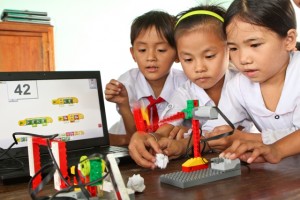Monthly Archives: November 2015
Hands-on Learning in STEM: Why is it so important?
Like many other elementary-age students, boxed science kits were a staple of my childhood. From growing sugar crystals to making glow-in-the-dark slime, I spent many an afternoon stirring concoctions and testing my experiments. I couldn’t have known it at the time, but practicing science in a hands-on, experimental way was changing the structure of my growing brain. Not only was it fostering a future interest in science, but it was also improving my scientific knowledge and abilities in STEM. Though boxed science kits surely aren’t the only way to do these things, hands-on scientific learning is crucial to a career in a STEM field. Interestingly enough, there may be gender differences in the amount of hands-on learning that children and older students engage in. For this reason, hands-on learning may play an important role in the gender gap we see in STEM fields.
The Big Two: Ability and Interest
Though there are many complex reasons why people choose certain careers, we can summarize the bulk of these reasons in two words: ability and interest. People tend to choose fields they 1) believe they are good at and 2) are passionate about. Job hours, prestige, and salary certainly also play into the equation, but are most often secondary factors. Access to hands-on learning plays a major role in both ability to do a certain job and interest in that career path.
Ability
There is certainly evidence that life experiences change the physical architecture of the brain, thus influencing its functioning. For example, in a well-known study on London cab drivers, it was found that the cab drivers had enlarged portions of their right posterior hippocampus relative to adults that did not require visual-spatial skills for their career. Cab drivers need complex way-finding skills to drive customers to where they need to be, skills that activate the right posterior hippocampus region of the brain. Interestingly, the study also found that the longer the person had been a cab driver, the more enlarged this region of the brain was (Halpern, 2007). Studies like this one suggest that cognitive ability is highly dependent upon life experiences and repeated training. This example discussed visual-spatial skills, but life experiences also build a number of other skills (such as mathematical ability and mental rotation skills) that are widely acknowledged to be important in STEM careers (Uttal, 2012). For this reason, opportunities for hands-on engagement in STEM activities that start at early ages may be crucial in building the skills that are needed for STEM professions.
Interest
In addition to physically changing certain regions of the brain, hands-on experience can also have a major impact on interest in particular fields. In a 2010 study, the effect of hands-on biological experiments on interest in those biological topics was investigated. It was found that, in general, interest levels of students who had performed hands-on experiments were higher than those who didn’t have hands-on exposure to the topic (Holstermann, 2010). Fostering an early interest in a certain topic can lead that person to seek out more related hands-on activities, increasing interest levels, and so on. Interest and passion are two of the most important factors in career choice and are also important qualities employers search for in job candidates.
Gender Differences
Unfortunately, access to the hands-on experience needed to build skills and interest in STEM fields may differ between males and females. Computer access in schools is one example; particularly in economically disadvantaged school districts, ability to use the computer often favors male students (DuBois, P. A., 1986). This situation may be improving as technology becomes increasingly common in the classroom, but teacher and parent encouragement for girls to participate in STEM activities may not be. Studies have shown that, when her children are engaged in a hands-on scientific activity, mothers are more likely to talk with their sons about the scientific process than they are with their daughters. This parental discussion and encouragement is important; interestingly, the amount of “science talk” the mothers engaged their child in correlated positively with the child’s later understanding of scientific texts (Hyde, 2007). In another similar study, parents and children in a museum were observed. When children were engaged in an interactive science exhibit, the parents were “three times more likely to explain science to boys than to girls” (Hyde, 2007). These studies show an unsettling gender gap in how parents react to their children’s engagement in hands-on science. Given that hands-on experimentation is a crucial factor in building the skills and interest needed for a STEM career, unequal access and encouragement to participate in hands-on learning may be a component in explaining the gender career gap.
Though ability and interest are indeed two of the most important factors in determining career paths, it is important to acknowledge that these factors are not solely shaped by environmental influences. There are certainly genetic factors that may predispose a strong ability or interest in STEM. Environmental components however, including hands-on learning and STEM experimentation, have been shown play an appreciable role. Ensuring that males and females have equal access to technology and science experiments, while also working to reduce gender biases surrounding hands-on learning in STEM at home and in the classroom, would allow males and females an equal opportunity to build STEM skills and interest early on in their education. If more females have the ability and the interest to pursue a career in STEM, then maybe the gender gap we see in STEM careers will come closer to closing. By explaining the scientific process to our girls at museums, or picking out a boxed science kit on glow-in-the-dark slime for her birthday, we are giving girls an equal opportunity to build the skills and the interest they need to pursue a career in STEM.
References:
DuBois, P. A., Schubert, J. G. (1986). “Do your school policies provide equal access to computers? Are you sure?” Association for Supervision and Curriculum Development. http://www.ascd.org/ASCD/pdf/journals/ed_lead/el_198603_dubois.pdf
Halpern, D. F. (2007). “Science, sex, and good sense”. Why Aren’t More Women in Science? S. J. Ceci, W. M. Williams (Ed.). Washington, DC: American Psychological Association.
Holstermann, N., Grube, D., Bögeholz, S. (2010). “Hands-on activities and their interest on students’ interest”. Research in Science Education, 40(5), 743-757.
Hyde, J. S. (2007). “Women in science: Gender similarities in abilities and sociocultural forces”. Why Aren’t More Women in Science? S. J. Ceci, W. M. Williams (Ed.). Washington, DC: American Psychological Association.
Uttal, D. H., Cohen, C. A. (2012). “Spatial thinking and STEM education: When, why, and how? Psychology of Learning and Motivation, 57, 147-181. http://groups.psych.northwestern.edu/uttal/documents/UttalandCohen.pdf
Posted in Uncategorized


